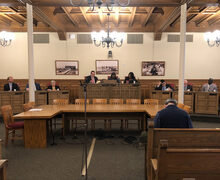President of Queens College explains how to combat anti-Asian racism
Daily Orange file photo
The virtual event was sponsored by the Center for International Services, Office of Diversity and Inclusion and Office of Multicultural Affairs.
Get the latest Syracuse news delivered right to your inbox.
Subscribe to our newsletter here.
Frank H. Wu, president of Queens College, City University of New York, said building bridges between minority groups and realizing shared ideals are two ways to fight anti-Asian racism.
Wu spoke about fighting anti-Asian racism and the necessity of an accurate worldview during a virtual event on Wednesday night, “Confronting Anti-Asian Racism.” The conversation was sponsored by the Center for International Services, Office of Diversity and Inclusion and Office of Multicultural Affairs.
“People ask me all the time, ‘How do Asian Americans fit in? Why aren’t we part of the conversation?’” Wu said.
Since the beginning of the coronavirus pandemic, anti-Asian racism and violence has increased in the public eye. In addition to Wu, students and faculty panelists also explained their own experiences with anti-Asian racism and vocalized that this has been something the community experienced long before the pandemic.
“Sometimes it’s the way I was looked at. Sometimes it’s the way I’m excluded from conversations,” said Kimberly Ng, a Syracuse University senior. “More often than not, it’s the way I’m repeatedly asked about where I’m from, where my parents are from and where my grandparents are from. A question I cannot satisfy until my answers prove I’m an other — that I don’t actually belong here.”
In Wu’s presentation “Asian American at a Cross Road,” he explained the important presence of Asian Americans throughout American history. Wu said that, for instance, Life Magazine featured an image of Yuri Kochiyama — a Japanese American woman and close confidant of Malcolm X — holding Malcolm X’s head while he died.
Wu also spoke about Asian Americans fighting in the Civil War. About 90 to 95% of workers who built the transcontinental railroad were Chinese laborers, Wu said. But during a celebration in Utah to unite the two railroad lines, Chinese Americans were excluded from photographs, he said.
“It turns out that Asian Americans have always been around much longer than people realize, and they have been allies,” he said.
Wu said that the model minority myth — a concept that disregards Asian American racism because the community is viewed as more successful than other minorities — is not a compliment.
“The dominant image is the model minority — that Asian Americans are whiz kid rocket scientists, they’re overachievers and super successful,” Wu said. “I applaud and credit anyone who is an overachiever. Good for them. That’s wonderful. This racial generalization, however, is not as positive as it seems.”
The model minority myth is misrepresentative, as it ignores income inequality among Asian Americans, Wu said. In many industries, Asian Americans are overrepresented in entry level positions, but not in high-level positions, he said.
Wu said that after watching the Derek Chauvin’s trial for the murder of George Floyd, Wu’s father told him that the actions of the police were wrong and ridiculous. The large amount of support towards the Black Lives Matter movement has given him hope, Wu said. This amount of support is what the Asian American community needs, he said.
“My job here is not to persuade you to think as I do,” Wu said. “It’s to provoke you to take action, to write the script of your own life, to break out of stereotypes. That ultimately is what America offers us, the opportunity to be who each one of us says we are. Not who somebody else says we are but who we truly are.”
Published on May 13, 2021 at 12:10 am
Contact Kailey: kmnorusi@syr.edu






